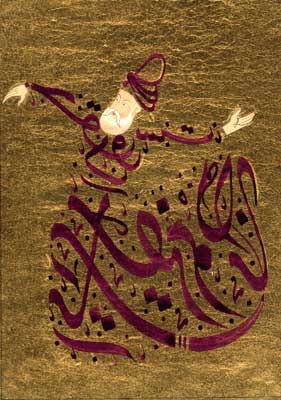 Gnosis and Gnosticism
Gnosis and Gnosticism  The Sufism
The Sufism
The Sufism |

|

|
| Written by JOSÉ ENRIQUE SALCEDO | |

The Sufism is a mystical islamic movement which distances itself from the traditionalist approach of Islam and tends to a more personal relationship with God. This underlines the importance of an inner search of God as a complement of the exterior order of 'shariah', meaning of the law. The word comes from 'suf' (wool) because the old storytellers, from which Sufism had evolved, wore wool clothes. The Sufists aim to lose themselves in the final reality of the divinity through the constant repetition of “dhikr” that is the mention of God. DHIKR is an arabic word which means 'remembrance' and it refers to the Sufi practice which implies the remembrance of God, the reciting of the names of God and the awareness of God’s presence. It can be done silently or in a loud voice, in solitude or in a group. This prolonged repetition of the name of God is for the Sufis a method of spiritual concentration. Aid is often used as music, a rosary, dance and systematic breathing exercises. This practice is validated by the Qur’an 33, 41: 'Oh, believers, remember God often and glorify Him at dawn and dusk.' For the Sufis, the dhikr is both an act of God and a human act. It is God the one who invokes himself, as is invoked by a believer. Most of God’s names are found in the sacred book; though some come from outside of Qur’an. The supreme name of Allah was common even before the era of the Qur’an, but its significance was transformed by the Qu’ran. A few examples with typical names of God are 'al-Haqq' (The Truth), 'al-Ahad' (The One), 'al-Hakam' (The Judge), 'al-Quddus' (The Saint), 'al-Kabir' (The Majestic), 'al-Karim' (The Generous), 'al-Wali' (The Protector), 'al-Wadud' (The Affectionate). Sometimes the word 'dhikr' is used to designate a Sufi ceremony in general but especially refers to the invocation of the Divine Name in the middle of the ceremony. As you can see, this practice corresponds closelly with 'the remembrance of the Being and with 'the Superlative Consciousness of the Being', which maintained moment by moment leads to the awakening of the objective consciousness. About all of these the V. M. Samael speaks: Let us remember the sage of Mallorca, Raimundo Lulio (1235 – 1315), who in 'The Book of a Hundred Names of God' established the method of the great masters of Islam: the Dhikr, which put the mystic in direct contact with the Divinity. Sufism began to be institutionalized quite early, when the Sufists formed steady communities in which they could live together and they could participate to educational activities. The Sufi centers were often formed on the basis of charitable funds (waqi) and they were developing their own lifestyle. The first groups of Sufists appeared in the 8th and 9th centuries. The School of Bagdad taught a systematic teaching of the stages of mysticism through the purifications of the senses and the spirit. Beginning with the 10th century a distancing between the Islamic orthodoxy and Sufism occurred. The Sufi institutions emphasized also the virtues such as humility and the care for the others. The V. M. Samael states precisely that the disinterested sacrifice for humanity is an essential element of a true school of regeneration. For this reason, the V. M. Sivananda indicates the asceticism as an essential characteristic of Sufism. The devotee consecrates all his physical, mental and spiritual actions to the will of God. The Union with God, the brotherhood between people and their own dedication to the Lord are the the most vital doctrines of Sufism. Sufism recognizes God with a form, but also recognizes His aspect without form. Sufism combines the ecstasy with the service for humanity. Sivananda underlines the following eloquent words of Qu’ran: Let us remember that giving alms and doing acts of charity is one of the five pillars of Islam. The Sufi institutions from the first period of Islam had evolved in the 12th century to the formal orders known as TARIQAHS. They were led by a spiritual elevated leader, known as a SHAYKH, and were formed by stable members (who may or may not have been married) and by laic adepts. The main orders were subdivided into hundreds of other orders. Although the main purpose was to increase the mystical consciousness of God, they fulfilled also an important missionary role, especially at the borders of the muslim world, in places like Central Asia, India, Sudan and Western Africa. The V. M. Samael affirms that in the missionary vocation there is sacrifice, and that 'if we wouldn’t do anything to carry the light of knowledge to other people, nations and languages, we would fall into a spiritual egoism, very refined, that would hinder us in any inner progress'. To love without asking for anything in return, to eliminate resentment, to forgive correctly the defects of the other, to give your life to the neighbour, any true sacrifice is rewarded by God. |
| < The Adversaries of Gnosis | The Gnostic Gospels > |
|---|
| Science |
| Art |
| Philosophy |
| Mysticism/Religion |
| Barbelo: Gnosis Magazine |